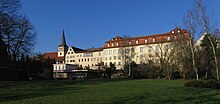Ingelfingen New Castle
The New Ingelfingen Castle , also called Residenzschloss Ingelfingen or Lower Castle , is a castle in Ingelfingen in the Hohenlohe district that was built at the beginning of the 18th century . It served as the residential palace of the Counts and Princes of Hohenlohe-Ingelfingen until 1806 . The castle was used differently in the 19th and 20th centuries. Ingelfingen's city administration has been located in the New Palace since 1988.
history
In Ingelfingen, after the destruction of Lichteneck Castle in the 15th century, a castle was built as a mansion for the Counts of Hohenlohe. This was built from 1625 to 1627 by Count Philipp Ernst von Hohenlohe-Langenburg as a two-part complex with farm buildings and mainly served the bailiff of Ingelfingen as a residence and apartment. After the death of Heinrich Friedrich von Hohenlohe-Langenburg , his inheritance was divided between his sons Albrecht Wolfgang, Friedrich Eberhard and Christian Kraft in 1701. Ingelfingen, which had come into the possession of Christian Kraft, became the new residence of the Hohenlohe-Ingelfingen line. For this purpose, Christian Kraft von Hohenlohe-Ingelfingen had the old official residence demolished and the New Palace built instead from 1705 to 1712. In 1723 the castle was extended to the east due to lack of space. In 1764 Heinrich August von Hohenlohe-Ingelfingen was raised to the rank of prince and the New Palace became the prince's residence. As early as 1780 to 1786 the palace was refurbished by the then Hereditary Prince Friedrich Ludwig von Hohenlohe-Ingelfingen. In the 19th century the castle was hardly used by the princes of Hohenlohe and had to be renovated in 1843 and 1844. However, even after the renovation, the princes lost interest in the New Palace. In the last decades of the 19th century it was empty. In the first half of the 20th century, the citizens of Ingelfingen used parts of the castle as a dental practice, city library or apartments. In 1962 it was acquired by the city of Ingelfingen. After a thorough renovation between 1984 and 1988, the castle has been the seat of the Ingelfingen city administration since 1988.
description
The complex consists of two three-story rectangular buildings, which are connected to one another by a narrow building to the south with a staircase resembling a central projectile . The complex is thus a three-wing complex with a north-facing courtyard . This is separated from the street by a wall with two gates. In the south of the castle there is a garden belonging to the castle with a jubilee column from 1793.
literature
- City of Ingelfingen (Ed.): The Ingelfingen Castle - once the residence, today the town hall. Self-published, Ingelfingen 1999.
Individual evidence
- ^ City of Ingelfingen (ed.): The Ingelfinger Castle. P. 12.
- ↑ a b Dagmar Zimdars (Ed.): Georg Dehio: Handbook of German Art Monuments. Baden-Württemberg I. Deutscher Kunstverlag, Berlin and Munich, 1993, ISBN 3-422-03024-7 , p. 383.
- ^ City of Ingelfingen (ed.): The Ingelfinger Castle. Pp. 43-47.
- ↑ Max Miller , Gerhard Taddey (ed.): Handbook of the historical sites of Germany . Volume 6: Baden-Württemberg (= Kröner's pocket edition . Volume 276). 2nd, improved and enlarged edition. Kröner, Stuttgart 1980, ISBN 3-520-27602-X , p. 373.
- ^ State archive Baden-Württemberg (ed.): The Hohenlohekreis. Thorbecke, Ostfildern, 2006, ISBN 3-7995-1367-1 , p. 392.
Coordinates: 49 ° 18 ′ 2.5 ″ N , 9 ° 39 ′ 6.1 ″ E


